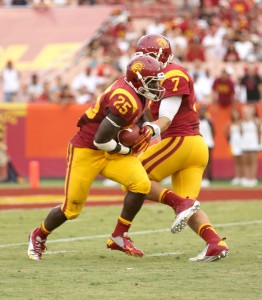Trojans OK with grind-it-out style
USC coach Lane Kiffin often structures his offensive game plan around giving wide receivers sophomore Marqise Lee and junior Robert Woods the ball in space and trusting they will more often than not elude tacklers and spring free for sizable gains.

Breakthrough · Even after struggling to net 26 rushing yards at Stanford on Sept. 15, USC coach Lane Kiffin did not shy away from running the ball against Cal. Silas Redd gained 158 yards, a season high. – Chris Pham | Daily Trojan
Of course, opposing coaches are aware of this strategy, which is why USC is starting to encounter defensive schemes designed to blanket the two Biletnikoff Award candidates and force other Trojans to shoulder the offensive burden.
Last Saturday against California, senior Curtis McNeal and junior Silas Redd — a vaunted backfield duo entering 2012 — finally validated the many who expected USC’s offense to be more balanced between the run and the pass than it had been through the first three games.
“We’re seeing a change in defenses,” Kiffin said. “Almost every week that we play, we’re seeing a complete game plan about No. 9 [Lee] and No. 2 [Woods]. That’s one of the good things about throwing those guys the ball so much in the first couple of games: People do what they did today. They spend the whole week trying to take away those two guys, and that opens up your running game.”
Facing a Cal defense fixated on not allowing the deep ball, McNeal and Redd combined for 273 yards on 31 carries in the game for a hefty 8.8 yards-per-carry average. In fact, it was the first time since 2008 that two Trojans ran for at least 100 yards apiece in the same game.
“If defenses are going to stay back and play cover-two shell and force us to run, then we got to do it,” senior quarterback Matt Barkley said.
The cover-two defense Cal used — a version of which USC employs itself — is designed to prevent long pass completions. In its base form, the cover-two is a zone defense with no man-to-man coverage played from a four-three personnel set (four defensive linemen, three linebackers). Two safeties divide the field into two deep zones, starting from about 15 yards off the line of scrimmage. Four defensive linemen rush the quarterback, while the three linebackers and two cornerbacks generally separate the field in front of the safeties into five smaller zones.
Often facing only seven defenders in the middle of the field near the line of scrimmage — or in the “box” — last Saturday, USC sought to exploit the favorable running matchup at the expense of the more prolific passing numbers the Trojans usually amass.
Though the game wasn’t Barkley’s flashiest performance, the veteran recognizes there are multiple ways to score points.
“I don’t think we’re trying to win a certain way,” Barkley said about the shift in offensive approach. “I think we’re trying to score as many points as possible.”
Aside from the type of defense Cal employed, Kiffin also diagnosed some favorable personnel matchups on film and knew the ground attack would be buoyed by senior center Khaled Holmes’ return to the starting lineup.
“We thought we had some matchups that we liked [in the running game] up front,” Kiffin said. “Obviously, Khaled being back made a big difference for us — as you can see in the games he’s played versus the game he didn’t play — when it comes to running the ball and not giving up sacks.”
Holmes, who exited the game in the fourth quarter after apparently re-aggravating the ankle he injured in the Syracuse game on Sept. 8, shored up a maligned offensive line unit that contributed to a paltry 26 net rushing yards against the Cardinal two weeks ago. His only notable mistake was a holding penalty he took on the Golden Bears’ six-yard line that negated a McNeal touchdown scamper.
Still, USC strayed from its game plan and seemed hesitant to commit fully to the run at the beginning of the second half.
Even after a first half in which Trojan running backs combined for 166 yards on just 13 carries and really only faltered once when Redd couldn’t convert third-and-one and fourth-and-one opportunities on a first-quarter drive, USC began the second half with a three-and-out on three consecutive pass plays.
On the next series, Redd carried the ball on the first two plays for 20 combined yards as USC returned to the ground game. But McNeal fumbled on the Trojans’ 45-yard line in the series, and whether USC would revert back to a pass-heavy attack was in question.
Kiffin didn’t overreact, however, and continued to allow the duo to salt away the clock for the duration of the contest.
“The two backs ran hard right from the beginning,” Kiffin said. “We put the ball on the ground one time, but other than that [we played well].”
Redd, who averaged a mere 1.3 yards per carry against Stanford, was pleased with how the offensive line and running backs worked in tandem to bounce back from a dispiriting performance.
“[The offensive line and running backs] had their best week of practice,” Redd said of the week leading up the Cal game. “They came out firing and really hit [Cal] in the mouth right from the first snap. We didn’t let our foot off the pedal.”
Entering the bye week, USC’s offense can pull confidence from its showing against Cal, knowing that, no matter what kind of defensive schemes it encounters, it can adjust accordingly and score points using different players and plays.
“We all know we can throw the ball well if we want to and that we have the great skilled players in the receiving game to do that,” Kiffin said in his weekly Sunday conference call. “But it was more critical for this team to build confidence in the offensive line and running backs.”
